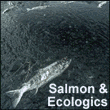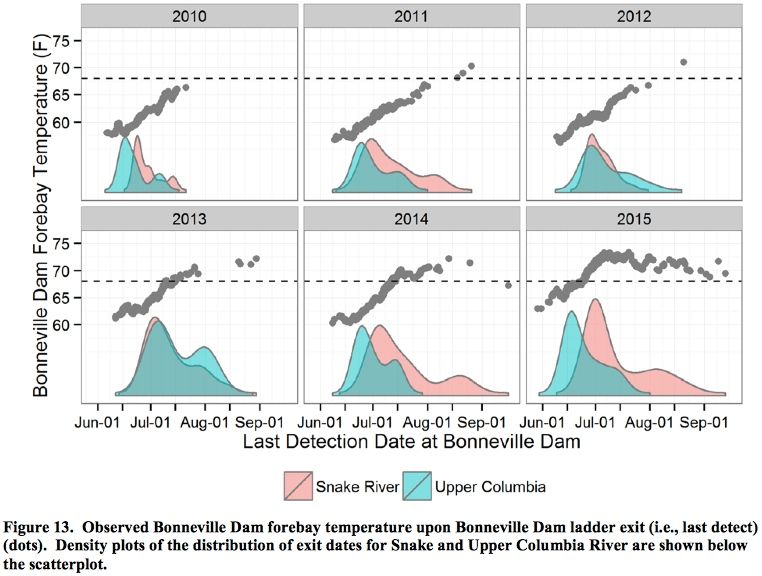forum
library
tutorial
contact

Study: Factors Influencing Juvenile Salmon/Steelhead SurvivalAccumulate as Fish Pass Multiple Dams
by StaffColumbia Basin Bulletin, August 12, 2016
|
the film forum library tutorial contact |

|
Study: Factors Influencing Juvenile Salmon/Steelhead SurvivalAccumulate as Fish Pass Multiple Damsby StaffColumbia Basin Bulletin, August 12, 2016 |
And the frequency at which they encounter the dams limits their ability to "recover from one set
of deleterious conditions before experiencing another significant disturbance," the
 During high flow years the number of dams juvenile chinook salmon and steelhead pass on their downstream passage to the sea determines their downstream migration survival, according to a recent study.
During high flow years the number of dams juvenile chinook salmon and steelhead pass on their downstream passage to the sea determines their downstream migration survival, according to a recent study.
The study looked at survival of the fish passing one, two and three dams on the Columbia River during a 2011 high flow event that led to involuntary spill, creating an environment of supersaturated dissolved gas.
Researchers used acoustic transmitters and a system of hydrophone arrays at Bonneville, The Dalles and John Day dams to calculate the survival of yearling chinook and steelhead that pass the dams. They did this by comparing passage data for each of the fish with the exact environmental conditions they experienced at the moment of their passage.
According to the study, "Factors influencing the survival of outmigrating juvenile salmonids through multiple dam passages: an individual-based approach," published online June 16 in the journal Ecology and Evolution, researchers "applied a unique index of biological characteristics and environmental exposures experienced by each fish individually as it migrated downstream, in order to examine which factors most influence salmon survival."
The researchers found that smolt survival was strongly influenced by barometric pressure, the speed at which the fish transited the dams and water temperature, among other factors.
However, the effect on the fish was compounded by passing multiple dams compared to fish that passed just one or even two of the dams.
"Despite spatial isolation between dams in the Lower Columbia River hydrosystem, migrating smolt appear to experience cumulative effects akin to a press disturbance." And the frequency at which they encounter the dams limits their ability to "recover from one set of deleterious conditions before experiencing another significant disturbance," the study says.
A press disturbance causes chronic stress in the migrants and is long-lasting, whereas a pulse disturbance creates acute stress and, given the opportunity, the smolt can recover. In general, the study found that fish passing one or two dams creates a pulse disturbance, but after passing the third dam, chronic exposure causes cumulative negative effects.
"The frequency and duration in which smolts encounter the altered environmental conditions associated with dams in the Lower Columbia River appears to result in chronic exposures, preventing the recovery of these fish between exposures," said researcher Tim Elder, a PhD Candidate at Portland State University's Department of Environmental Science and Management.
Elder's co-authors are Christa Woodley, research ecologist at the U.S. Army Engineer Research and Development Center, Mark Weiland, senior managing scientist at Anchor QEA, and Angela Strecker, assistant professor of Environmental Science and Management at PSU.
For example, Elder said, increased spillway discharge had little effect on fish passing one or two dams but substantially increased survival estimates for fish passing three dams.
Similarly, fish velocity had little effect on the survival of fish passing a single dam but the survival of fish passing three dams was strongly influenced by velocity, with slower fish having lower survival than faster fish.
The survival of yearling chinook passing one dam was 87.8 percent, two dams was 83.8 percent and fish that passed three dams was 81.7 percent, the study said. For steelhead, survival was 90.7, 86.1 and 84.3 percent for one, two and three dams.
As this shows, the survival of chinook and steelhead is similar and, therefore, actions taken to increase survival for one species would likely increase survival for the other species, says the study.
"The US Army Corps of Engineers has modified these dams to better accommodate the needs of migrating salmon and the dynamic river environment," Elder said. "However, additional structural and operational modifications to the dams that account for years of high flow volumes, involuntary spill and the ensuing elevated levels of total dissolved gas may be needed."
Other findings of the study are:

learn more on topics covered in the film
see the video
read the script
learn the songs
discussion forum
